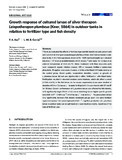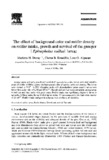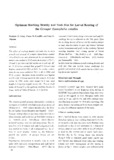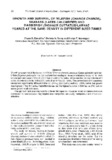Growth response of cultured larvae of silver therapon Leiopotherapon plumbeus (Kner, 1864) in outdoor tanks in relation to fertilizer type and fish density
Share
Abstract
This study evaluated the effects of fertilizer type and fish density on early growth and survival of silver therapon Leiopotherapon plumbeus (Kner, 1864) larvae reared in outdoor tanks. In the first experiment, larvae (1.92 ± 0.09 mm total length) were stocked into nine, 4 m3 tanks at an initial density of 0.5 larvae L-1 and reared for 42 days at an ambient temperature of 28.8–30.7°C. Three treatments with three replicates each were compared: organic (chicken manure, OF) or inorganic fertilizers (ammonium phosphate, IF) applied once every 2 weeks, and the unfertilized (NF) tanks serving as the control group. Water quality, zooplankton densities, survival or growth of L. plumbeus larvae did not vary significantly in either fertilized or unfertilized tanks. Fertilization resulted in elevated nutrient concentrations, which did affect survival (2.10%–6.07%) of the fish larvae. In the second experiment, larvae were stocked at densities of 0.4 or 0.6 larvae L-1 in tanks fertilized at 4–5 days interval with OF and IF for 30 days. Growth performance of L. plumbeus larvae was affected by fish density, with significantly larger (20.04 ± 2.65 mm in total length) and higher specific growth rate (SGR; 6.97 ± 0.48% day-1) at 0.4 larvae L-1 than at 0.6 L-1. Fry production did not vary significantly between fish density treatment groups given the same fertilizer types, but survival rates were improved at 0.4 L-1. Together, production of L. plumbeus larvae in outdoor tanks can be optimized at a lower stocking density, regardless of the type of fertilizer used.
Suggested Citation
Aya, F., & Garcia, L. M. (2016). Growth response of cultured larvae of silver therapon Leiopotherapon plumbeus (Kner, 1864) in outdoor tanks in relation to fertilizer type and fish density. Journal of Applied Ichthyology , 32(6), 1186-1193. https://doi.org/10.1111/jai.13138
Subject
growth rate  ; fish
; fish  ; ammonium compounds
; ammonium compounds  ; survival
; survival  ; growth
; growth  ; fertilization
; fertilization  ; density
; density  ; larvae
; larvae  ; zooplankton
; zooplankton  ; phosphates
; phosphates  ; fertilizers
; fertilizers  ; tanks
; tanks  ; organic wastes
; organic wastes  ; fry
; fry  ; water quality
; water quality  ; temperature effects
; temperature effects  ; fish larvae
; fish larvae  ; mineral nutrients
; mineral nutrients  ; stocking density
; stocking density  ; agrochemicals
; agrochemicals  ; ammonium
; ammonium  ; Ambient temperature; Nutrient concentrations; Above ground tanks; water tanks
; Ambient temperature; Nutrient concentrations; Above ground tanks; water tanks 
 ; fish
; fish  ; ammonium compounds
; ammonium compounds  ; survival
; survival  ; growth
; growth  ; fertilization
; fertilization  ; density
; density  ; larvae
; larvae  ; zooplankton
; zooplankton  ; phosphates
; phosphates  ; fertilizers
; fertilizers  ; tanks
; tanks  ; organic wastes
; organic wastes  ; fry
; fry  ; water quality
; water quality  ; temperature effects
; temperature effects  ; fish larvae
; fish larvae  ; mineral nutrients
; mineral nutrients  ; stocking density
; stocking density  ; agrochemicals
; agrochemicals  ; ammonium
; ammonium  ; Ambient temperature; Nutrient concentrations; Above ground tanks; water tanks
; Ambient temperature; Nutrient concentrations; Above ground tanks; water tanks 
Collections
- AQD Journal Articles [1249]
Related items
Showing items related by title, author, creator and subject.
-
The effect of background color and rotifer density on rotifer intake, growth and survival of the grouper (Epinephelus suillus) larvae
Duray, Marietta N.; Estudillo, Chona B.; Alpasan, Lota G. (Elsevier, 1996)Rotifer intake and early growth and survival of Epinephelus suillus larvae were determined in terms of rotifer visibility against the background color of rearing tanks and density. The larvae were stocked at 30 l−1 ... -
Optimum stocking density and tank size for larval rearing of the grouper, Epinephelus coioides
Duray, Marietta N.; Estudillo, Chona B.; Alpasan, Lota G. (Asian Fisheries Society, 1997)The effect of stocking of stocking density and tank size on early growth and survival of grouper, Epinephelus coioides (=suillus) larvae were determined. In one experiment, larvae were stocked in 500L tanks at densities ... -
Growth and survival of milkfish (Chanos chanos), seabass (Lates calcarifer) and rabbitfish (Siganus guttatus) larvae reared at the same density in different sized tanks
Estudillo, Chona B.; Duray, Marietta N.; Marasigan, Evelyn T. (Society of Israeli Aquaculture and Marine Biotechnology, 1998)Growth and survival of the larvae of milkfish (Chanos chanos), seabass (Lates calcarifer) and rabbitfish (Siganus guttatus) in 40, 200 and 500 liter rearing tanks were evaluated at day 14. Milkfish larvae survived better ...




